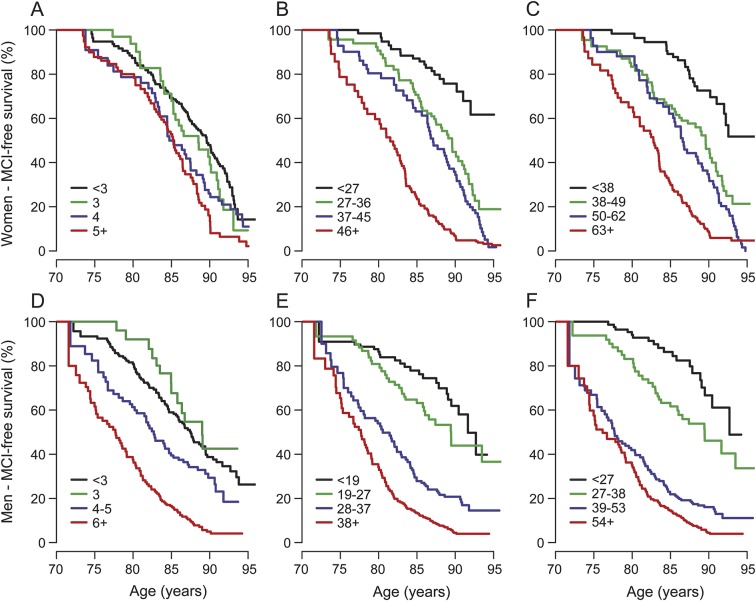Figure. Kaplan–Meier curves for MCI-free survival among participants in the MCSA, classified by quartiles of the cross-validated MCI risk scores measured at baseline.
Panels A and D correspond to the basic clinical model. Panels B and E correspond to the augmented clinical model. Panels C and F correspond to the augmented clinical model after the addition of APOE ε4 carrier status. Panels A, B, and C show data from women and panels D, E, and F show data from men. Women classified into the second, third, and fourth quartiles of the risk score by the basic model were 1.3 (95% CI: 0.8, 2.0), 1.4 (95% CI: 1.0, 2.0), and 2.1 (95% CI: 1.5, 3.0) times as likely to progress to MCI as women classified into the first quartile (A). Men classified into the second, third, and fourth quartiles of the risk score by the basic model were 0.9 (95% CI: 0.5, 1.6), 1.3 (95% CI: 0.9, 1.9), and 3.0 (95% CI: 2.2, 4.2) times as likely to progress to MCI as men classified into the first quartile (D). Women classified into the second, third, and fourth quartiles of the risk score by the augmented model were 2.7 (95% CI: 1.5, 4.6), 4.2 (95% CI: 2.5, 7.1), and 7.2 (95% CI: 4.3, 12.1) times as likely to progress to MCI as women classified into the first quartile (B). Men classified into the second, third, and fourth quartiles of the risk score by the augmented model were 1.8 (95% CI: 1.1, 3.2), 4.0 (95% CI: 2.4, 6.6), and 7.1 (95% CI: 4.4, 11.5) times as likely to progress to MCI as men classified into the first quartile (E). After adding APOE ε4 carrier status to the augmented model, women classified into the second, third, and fourth quartiles of the updated risk score were 2.2 (95% CI: 1.3, 3.7), 3.6 (95% CI: 2.2, 5.9), and 6.0 (95% CI: 3.7, 9.6) times as likely to progress to MCI as women classified into the first quartile (C). Likewise, men classified into the second, third, and fourth quartiles of the updated risk score were 2.0 (95% CI: 1.1, 3.6), 4.6 (95% CI: 2.8, 7.8), and 7.5 (95% CI: 4.5, 12.4) times as likely to progress to MCI as men classified into the first quartile (F). CI = confidence interval; MCI = mild cognitive impairment; MCSA = Mayo Clinic Study of Aging.

